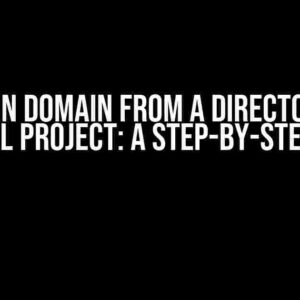If you’re a .NET Core developer, you might have stumbled upon the infamous “WebMvcTagsContributor is deprecated” warning while working on a project. It’s natural to wonder what this means and, more importantly, what you can do about it. In this article, we’ll delve into the world of tag helpers, explore the deprecated WebMvcTagsContributor, and discover the alternative that will keep your project thriving.
What is WebMvcTagsContributor?
Before we dive into the deprecation, let’s quickly review what WebMvcTagsContributor is. WebMvcTagsContributor is a class in .NET Core that allows you to add custom tag helpers to the Razor view engine. Tag helpers are a way to extend the functionality of HTML elements in your views, making it easier to reuse code and reduce boilerplate.
<td><my-checkbox asp-for="IsEnabled"></my-checkbox></td>In the example above, `my-checkbox` is a custom tag helper that generates a checkbox HTML element with the necessary attributes. WebMvcTagsContributor was the go-to way to register these custom tag helpers in your .NET Core application.
Why is WebMvcTagsContributor Deprecated?
As of .NET Core 3.0, the WebMvcTagsContributor class has been marked as deprecated. This means that it will eventually be removed in future versions of .NET Core. The reason behind this deprecation is to simplify the way tag helpers are registered and discovered in the framework.
The problem with WebMvcTagsContributor is that it relies on a complex and convoluted system of registration, which can lead to issues with tag helper discovery and loading. By deprecating this class, the .NET Core team aims to promote a more modular and flexible approach to tag helper registration.
What’s the Alternative?
So, what’s the alternative to WebMvcTagsContributor? Enter `ITagHelper_activator`! This interface is the new recommended way to register and load tag helpers in your .NET Core application.
<services>
<add type="MyTagHelperActivator" />
</services>In the example above, we’re registering an instance of `MyTagHelperActivator` as a service in the Startup.cs file. This activator will then be responsible for loading and registering our custom tag helpers.
Creating an ITagHelper_activator
To create an ITagHelper_activator, you’ll need to implement the `ITagHelper_activator` interface, which has a single method, `Activate`.
public class MyTagHelperActivator : ITagHelper_activator
{
public void Activate(TagHelperContext context)
{
// Register your custom tag helpers here
context.Add(new MyCheckboxTagHelper());
}
}In the `Activate` method, you can register your custom tag helpers using the `TagHelperContext` instance provided. In this example, we’re registering a `MyCheckboxTagHelper` instance.
Registering Tag Helpers
To register a tag helper, you’ll need to create a class that inherits from `TagHelper` and override the `Process` method.
public class MyCheckboxTagHelper : TagHelper
{
public override void Process(TagHelperContext context, TagHelperOutput output)
{
// Generate the checkbox HTML element
output.TagName = "input";
output.TagMode = TagMode.SelfClosing;
output.Attributes.Add("type", "checkbox");
output.Attributes.Add("checked", "checked");
}
}In the `Process` method, you can manipulate the `TagHelperOutput` instance to generate the desired HTML element. In this example, we’re generating a checkbox input element.
Migrating to ITagHelper_activator
If you’re already using WebMvcTagsContributor in your project, don’t worry! Migrating to ITagHelper_activator is relatively straightforward.
Here’s a step-by-step guide to help you migrate:
-
Remove the WebMvcTagsContributor registration from your Startup.cs file.
-
Create a new class that implements ITagHelper_activator.
-
Register the new activator instance as a service in the Startup.cs file.
-
Update your custom tag helpers to inherit from TagHelper and override the Process method.
-
Register your custom tag helpers in the ITagHelper_activator implementation.
Conclusion
In conclusion, WebMvcTagsContributor is deprecated, but that’s not a reason to panic. By switching to ITagHelper_activator, you’ll enjoy a more modular and flexible way of registering and loading tag helpers in your .NET Core application.
Remember, it’s essential to stay up-to-date with the latest developments in .NET Core and adapt to changes like this to ensure your project remains maintainable, efficient, and rock-solid.
| Before | After |
|---|---|
| WebMvcTagsContributor | ITagHelper_activator |
| Complex registration | Simplified registration |
| Tag helpers registration | Modular tag helper registration |
By following this guide, you’ll be well on your way to embracing the new and improved way of working with tag helpers in .NET Core. Happy coding!
Further Reading
Frequently Asked Question
With the deprecation of WebMvcTagsContributor, many developers are left wondering what’s next. Worry not, friends! We’ve got you covered with these five FAQs that’ll guide you through the alternatives and more.
What is WebMvcTagsContributor and why was it deprecated?
WebMvcTagsContributor was a class in Spring Framework that allowed users to register custom tags for use in views. However, with the introduction of Spring WebFlux, this class became redundant and was eventually deprecated. The good news is that there are better alternatives available!
What are the alternatives to WebMvcTagsContributor?
One popular alternative is the WebMvcConfigurer interface, which provides a more flexible and modular way of customizing the MVC configuration. You can also use the @EnableWebMvc annotation to enable MVC configuration. Additionally, you can create a custom implementation of the WebMvcConfigurerAdapter class to register custom tags.
How do I migrate my existing code to use the new alternatives?
Migrating your code is relatively straightforward. Start by removing the WebMvcTagsContributor class and replace it with a custom implementation of the WebMvcConfigurer interface. Then, move your tag registration code to the addViewControllers method or the addTag method, depending on your specific requirements.
Will I need to rewrite all my custom tags from scratch?
Not necessarily! If your custom tags were previously registered using WebMvcTagsContributor, you can reuse them with minimal modifications. Simply update the registration code to use the new alternatives, and you’re good to go!
What are the benefits of using the new alternatives?
The new alternatives offer a more modular, flexible, and efficient way of customizing your MVC configuration. You’ll enjoy better performance, improved maintainability, and a more scalable architecture. Plus, you’ll be future-proofing your code against upcoming changes in Spring Framework!






